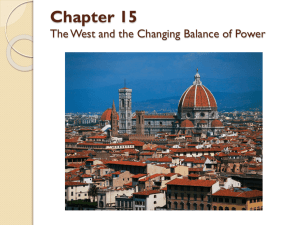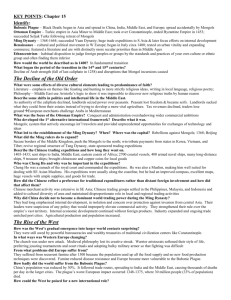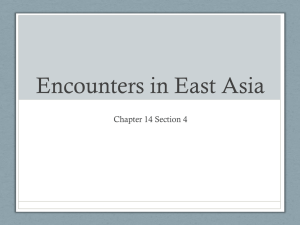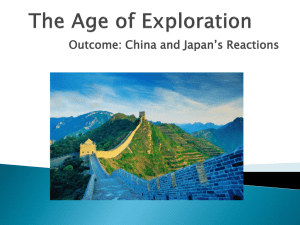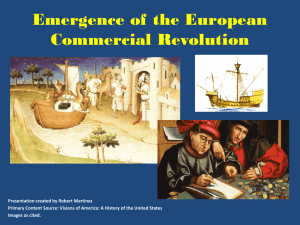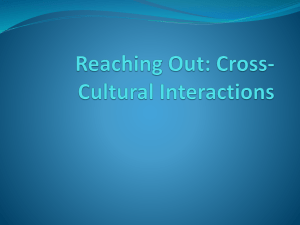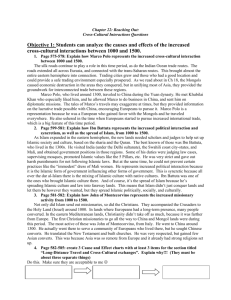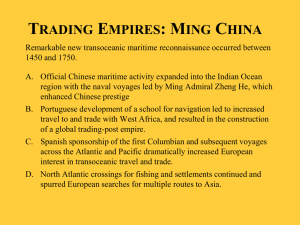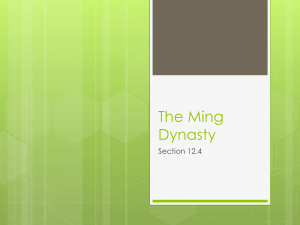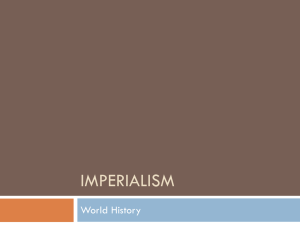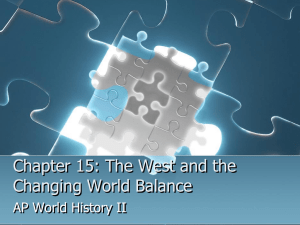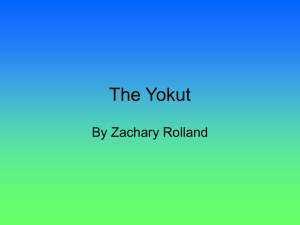Chapter 15 PP
advertisement
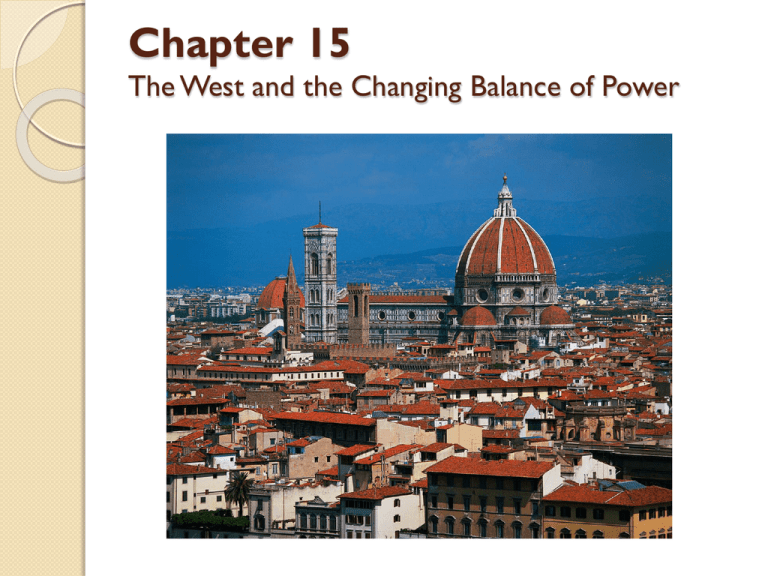
Chapter 15 The West and the Changing Balance of Power A World in Transition (#1) Two events signaled a profound transition in the balance of world power by the year 1400: ◦ 1) The downfall of the last Arab caliphate in 1258. The Arabs had been a source of stability for over 600 years. ◦ 2) Mongols invasions had caused severe disruption to the stability of Asia and Eastern Europe. With their empire all but gone, these regions began to regain their own economic and cultural ways. Decline in the Middle East Along with Mongol invasion, there were other setbacks that led to the decline of Muslim culture and economy. ◦ 1) Intellectually, works of literature, art, and philosophy were replaced by strictly religious themes. This stifled the ingenuity and creativeness of many Muslim thinkers. ◦ 2)Economically, the landlord classes seized power over the peasantry and neglected to create any new agricultural techniques. Tax revenues steadily declined as well. Averroes (Ibn Rahud) was a Spanish Muslim scholar who wrote extensively on Aristotle’s works. He is considered to be the “founding father of secular thought in Western Europe”. This statue in Cordoba, Spain is a testament to his impact in Europe. The Ottoman Rise Though the caliphate’s fall was detrimental to Islam, it was not fatal. Roughly 30 years after Baghdad was sacked, Ottoman Turkish soldiers would create a new Muslim state in the region that engulfed most of the lands of the Middle East and of the Byzantine Empire. Ottoman Impact on Trade Though the Ottomans continued to trade actively in the Mediterranean zones, they did not promote long distance maritime trade like their preceding Muslim empires. As a result, Muslim influence in Indian Ocean trade had declined significantly by 1400, allowing new powers (Chinese and Europeans) to take hold in that region. Mongol Trading Network (#2) Their holdings throughout the Far East, central Asia, the Middle East, and Eastern Europe connected far reaching areas together. This empire encouraged interregional travelers and provided great opportunities for trade and exchange of technology and ideas. Chinese are the first to challenge for power after Mongol fall. Western Europeans arrived in the Indian Ocean in the late 1400s. Who’s next??? (#3) Chinese expansion (at least briefly!) After expelling the Mongols in 1368, the Ming gov’t begins reforming China. The Ming government begins to fund huge state-sponsored trading expeditions to southern Asia and beyond. (#4) These fleets numbered nearly 3,000 shipping vessels, 400 armed naval ships, and longdistance ships. Nine great treasure ships (junks) monitored the Indian Ocean from China all the way to the Persian Gulf and the Red Sea. (#5) Admiral Zheng He (#6) An imperial eunuch and admiral who led great trading expeditions on behalf of the Ming emperor from 1405-1433. He was also a Muslim, therefore, he could establish lasting trade contacts with the Arab world. His expeditions took Chinese goods to the Middle East, Africa, and India, and also brought back luxury and exotic goods. A Chinese Recall (#7) In 1433, Zheng He’s fleets were called back to China. Bureaucrats, jealous of his growing power, argued that the expeditions were too expensive and that the money could be better used elsewhere, like fighting nomadic threats and the ongoing construction of Beijing. Also, the new Ming emperor wanted to distance himself from the policies of his predecessor. Zheng He’s Voyages ZHENG HE’S TOMB Leading to his tomb a 4 sets of stairs with 7 steps each, totaling 28 steps. Zheng He made 7 voyages with his imperial fleet over his 28 year naval career. Back to the Norm (#8) For the Chinese, a withdrawal from international trade was simply a return to the status quo. Never ones for foreign dependence, the cancelling of Zheng He’s expeditions in 1433, reaffirmed the Chinese policy of isolationism that had been the norm throughout their history. Rise of the West (#10) For western Europe, who had been mired in the Middle Ages, their location in relation to the Mongol Empire was actually perfect. They were: ◦ A) Close enough so as to benefit from trade and exchange (printing, the compass, and explosive powder) due to the Mongols tolerant policy of free trade. ◦ B) Spared from the wrath of destruction that so many other cultures experienced from the Mongol raids. Rise of the West (#9) These advantages helped European economy slowly pick back up. But, Europe was facing tough problems in other areas: ◦ A) Church- The Church’s influence was weakening in the face of divisions and no theological explanations for the Bubonic plague. People began to question its authority and seek their own gains instead. ◦ B) Famine – Recurring famine in the 1300’s due to increased population and no new agricultural inventions to increase food supply FORCED Europeans to look for new agricultural methods to feed its people. Rise of the West cont’d (#9) ◦ C)Plague – Ironically, the plague helped solve the problem of food shortage by killing 1/3 of Europe’s population. Also, with fewer workers, wages went up and investments in business and commerce increased. * Believe it or not, the plague eventually led to economic growth. Famine (fear of starvation) proved to be a great motivator for Europeans to find solutions to their problems. THE BLACK DEATH Medieval manuscript depicting plague victims being buried. THE BLACK DEATH European Map highlighting the path of the plague An Asian Obsession (#11) Of course, another issue encouraged Europeans to branch out: Asian goods!!! The elite, upper classes of western Europe had become obsessed with the more refined products of Asia like spices, silks, perfumes, and jewels. The cruder European goods such as wool, copper, tin, honey, and salt could not make up the discrepancy in value. The balance had to be made up in gold shipments to Asia. This created a gold famine in Europe which threatened to collapse the entire European economy. The solution to this problem was to find more gold!!! So, Europeans began exploring (more on that later). Asian goods Gold European goods > Wool Renaissance (#12) The Renaissance was a cultural and political movement in Western Europe that began in Italy in the 1400’s. There was an emphasis on artistic and architectural output. As a result, not only were paintings and sculptures created, but cathedrals, bridges, plazas, etc. This created jobs and higher incomes, making the Renaissance not just a cultural, but an economic revolution as well. Florence, Italy Genoa, Italy Cities began competing with one another over trade and commercial rights as well as artistic superiority. Medieval art (Religiously focused) Renaissance art (Human emphasis) While Renaissance art and culture remained religiously dominated, there was more of an emphasis on realistic portrayals of humans and nature.This was known as humanism and was more secular than medieval art. (#13) HUMANISM As the subject matter of art moved more towards humans and nature, painters began focusing less on the religious and more on the worldly. The Florentine painter Giotto led the way in this movement. Adoration of the Magi by Giotto Experimenting with Exploration (#14) Along with Italy, key developments were taking place in the Iberian peninsula (Portugal and Spain). In 1469, Ferdinand of Castille (a Spanish province) and Isabella of Aragon (another Spanish province) wed to create the famous dual monarchy of Ferdinand and Isabella. Devout Catholics, they began a military campaign to expel Arabs and Jews from their regions and eventually all of Spain. In this way, they clearly brought state affairs and religious affairs together. The government had a duty to promote and protect religion according to these rulers. Eventually, they would look to expand their power beyond Spain through exploration. Spain and Portugal developed governments willing to actively support religious mission and spread. Nautical Shortcomings (#15) European nations such as Spain, Portugal, and Italy began searching for routes to the “Indies” by the late 1200’s. However, Europeans lacked adequate navigational techniques which prohibited them from venturing into the Atlantic. Their ships, designed for the Mediterranean, were shallow-drafted and oar-driven. Eventually, through trade with Arabs and Chinese, Europeans acquired the compass and astrolabe as well as improved maps to aid their quests. Direct route to the “Indies” As navigation improved, European nations began looking for alternative routes to Asia that could help them bypass Muslim realms in the Middle East. Henry the Navigator – an exploration entrepreneur (#16) Henry the Navigator was a Portuguese prince with a fascination for exploration. A student of astronomy and nautical science himself, he funded about a third of all Portuguese voyages before his death in 1460. His motivations were scientific, intellectual, economic and religious. He also built a school of navigation in Portugal to train prospective explorers. Commercial Agriculture begins By 1439, the Portuguese had control of the Azores Islands and the Spanish soon took the Madeira and Canary Islands. They began growing cash crops like sugar and tobacco on these islands, and more importantly, imported African slaves for the first time to aid in this plantation style labor system. Azores Madeira Canary Is. European impacts in West Africa As Europeans made more significant contacts with sub-Saharan African cultures of west Africa, they profoundly shaped that region. ◦ 1) European weapons were introduced and played a leading role in tribal conflicts in that region. ◦ 2) These weapons were used to seize large numbers of African slaves for European use. ◦ 3) Trade shifted more to the Atlantic coast of Africa and away from the Mediterranean. It was, therefore, controlled more by Europeans than Muslims. European Arrival in the Americas (#17) When Europeans arrived in the late 1400’s to the lands of the Aztec and Inca, both New World empires were already in decline. The Aztec had many enemies due to enslavement and religious sacrifice while the Inca were over expanded and in the midst of a civil war. These factors (along with guns, steel weapons, and germs) made Spanish conquest very easy. Polynesian Cultures Another area that was developing independently in this period was Polynesia, particularly Hawaii and New Zealand. Hawaiian Culture The first Polynesians arrived in Hawaii via war canoes in the 7th century. Most Hawaiians lived in agricultural clusters and fishing villages. They imported pigs from Polynesian islands for a vital source of meat. The islands were divided into regional kingdoms that were very warlike with one another. Society was divided into different castes of priests, nobles, and commoners. New Zealand culture New Zealand’s culture centered around a native group of people known as the Maori. Like Hawaii, they were very warlike and divided along similar social lines. Their climate was considerably colder and more harsh. The Polynesian cultures were the last of the major cultures to be encountered by larger cultures.
